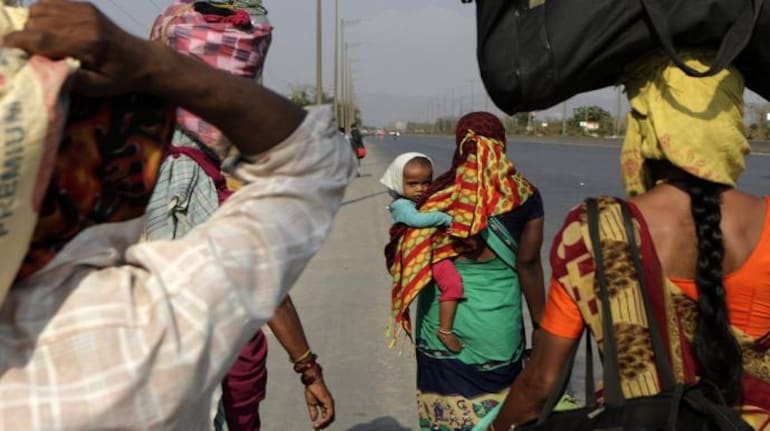



On April 19, an 8-day-old baby tested positive for COVID-19 in the Vasai-Virar municipal limits in Maharashtra's Palghar district. The case was registered at the Municipal Corporation’s Juchandra medical facility and despite their best efforts the doctors were unable to save the infant. This made the newborn India’s youngest COVID-19 casualty.
A day earlier, a 45-day-old infant passed away after testing COVID-19 positive at a hospital in New Delhi. Admitted to the Kalawati Saran Children’s Hospital on April 14, one of the biggest in Asia, she had tested positive for the virus on April 16. “Some of the other children admitted in the hospital are too small and on ventilator support. We are making arrangements to place them in safer areas, maybe another hospital with equivalent facilities, to reduce the risk of infection among them," the hospital authorities said in a statement, reflecting the growing panic from virus infection among newborns and infants.
A few days ago, a 21-month-old from Kolkata tested positive for COVID-19. A resident of Uttar Panchanna village in south Kolkata, the toddler was immediately shifted to the Belaghata ID and BG Hospital from the Institute of Child Health (ICH) after he tested positive.
Facing the brunt of the coronavirus pandemic are India’s newborn infants, a fact not first acknowledged when the virus broke amidst suggestions that it was only the old and infirm who were in the direct line of fire.
Mothers, newborns bear the brunt
According to latest reports, mothers and newborns are battling COVID’s harsh realities, including containment measures such as lockdowns and curfews, health centres overwhelmed with response efforts, supply and equipment shortages and lack of sufficient skilled birth attendants as health workers, including midwives, who are busy in tackling a never-ending queue of virus patients. As it is, the global average of nurses and midwives, which stands at 3.4 per 1000 population, is pegged at a lowly 2.1 in India. Now with many of them diverted to fighting the virus, the risks to the newborn have gone up manifold.
An estimated 20 million mothers and newborns will receive pregnancy and newborn care in India in the nine-month-period following declaration of the COVID-19 pandemic, according to UNICEF estimates. The highest numbers of births in the nine months since the pandemic was declared (on March 11) are expected to take place in India, where 20.1 million babies are projected to be born between March 11 and December 16, 2020.
The Union Ministry of Health and Family Welfare has prioritised maternal and newborn service continuity as a critical component of the overall COVID response. National guidelines on ensuring service continuity have been released to the states and districts to ensure that their response plans will ensure integration of reproductive, maternal, neonatal and child health (RMNCH) continuity.
The danger is compounded by the fact that India has had high neonatal mortality rates in normal times, much before the pandemic rocked the world. Significantly, these levels are most likely to increase under COVID-19 conditions. While no centrally tabulated figures are available about infant deaths in India’s growing tally, (which remains less than the world average in any case) numbers in preceding years sound ominous.
High neonatal mortality rates
According to 2019 statistics, India recorded a high number of 30.924 deaths per 1000 live births, which nonetheless showed a 3.36 percent decline from 2018.
Crucially, what is needed is immediate investment in health workers with the right training, who are equipped with the correct medicines to ensure every mother and newborn is cared for by a safe pair of hands to prevent and treat complications during pregnancy, delivery and birth.
Is that happening? Domestic supply chains are disrupted due to local bottlenecks, resulting in reduced availability of hormonal contraceptives, antenatal supplementation and malaria prevention, commodities for childbirth (for example, uterotonics), routine child vaccines and treatments for common
illnesses like antibiotics, anti-malarials or oral rehydration solution. These factors, according to the May 12, 2020, issue of the Lancet, are most likely to increase the deaths of both mothers and infants.
The article also highlights another factor determining daily lives these days – lockdowns and their impact. “There has been debate around the trade-off between establishing movement restrictions and minimising disruptions to business and economies. Our results show that the indirect effects of the pandemic are not merely economic. If the delivery of health care is disrupted, many women and children will die. Thus, while public health experts are advocating for social distancing, there is also a public health case for ensuring access to routine care. Our estimates quantify the potential effect on RMNCH and provide a reference point for policy makers,” the weekly peer-reviewed global general medical journal pointed out.
Importantly, disruption of these interventions — childbirth and child curative services — cannot be mitigated through post-outbreak activities or easily averted through vertical health programmes outside of the public health system. The vulnerability of these interventions to disruption, and their substantial consequences for mortality, highlight the need to ensure provision of these services throughout the pandemic and support citizens in using these services as safely as possible. In the days ahead, India would know exactly how they have fared in this battle that deals with this extremely vulnerable section of the Indian population that requires health care more than most.
Ranjit Bhushan is an independent journalist and former Nehru Fellow at Jamia Millia University. In a career spanning more than three decades, he has worked with Outlook, The Times of India, The Indian Express, the Press Trust of India, Associated Press, Financial Chronicle, and DNA.
Discover the latest Business News, Sensex, and Nifty updates. Obtain Personal Finance insights, tax queries, and expert opinions on Moneycontrol or download the Moneycontrol App to stay updated!
Find the best of Al News in one place, specially curated for you every weekend.
Stay on top of the latest tech trends and biggest startup news.